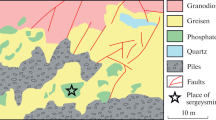Abstract
Hisingerite, first described in 1810, has been variously regarded as noncrystalline, as a septechlorite, as ferric allophane, as ferric halloysite and as poorly crystalline nontronite. Hisingerite from the original localities of Gillinge and Riddarhyttan in Sweden has a composition close to Fe2Oy2SiO22H2O. X-ray diffraction (XRD) analysis of Riddarhyttan hisingerite yields very broad maxima at 7.7, 4.44, 3.57, 2.56, 2.26, 1.69 and 1.54 Å, and that from Gillinge is similar. Cation exchange capacities are 2.2 meq/100 g (Riddarhyttan) and zero (Gillinge). Transmission electron microscopy (TEM) shows a fabric of concentric spheres and part spheres, with diameters of about 140 Å and walls up to six 7-Å layers thick. High-resolution images of the sphere walls reveal a 2-layer structure similar to that of kaolinite. A calculated diffraction pattern based on a model of 4 concentric shells of ferric kaolinite structure matches the observed pattern quite closely. Some other hisingerites, notably that from Bellevue King Mine, Idaho, show 10-Å layers as well as 7-Å layers, and this hisingerite has a CEC of 32 meq/100 g and a weak 15.5-Å X-ray reflection in addition to a pattern similar to Riddarhyttan hisingerite. It is concluded that hisingerite is a curved ferric 7-Å 1:1 layer silicate analogous to halloysite, and that many of the hisingerites reported in the literature contain admixed nontronite.
Similar content being viewed by others
References
Archimedes, ca 250 BC. On floating bodies. Book I.
Berzelius J J. 1819. Nouveau systeme de minéralogie. Paris: Méquignon-Marvis. 314 p.
Bowie SHU. 1955. Thucolite and hisingerite-pitchblende complexes from Nicholson Mine, Saskatchewan, Canada. Bull Geol Surv Gr Brit 10:45–55.
Brigatti MF. 1981. Hisingerite: A review of its crystal chemistry. Proc 7th Int Clay Conf. Dev Sedimentol 35:35–110.
Brindley GW, Goodyear J. 1948. X-ray studies of halloysite and metahalloysite. II. The transition of halloysite to metahalloysite in relation to relative humidity. Mineral Mag 28:28–215.
Church MA. 1870. Chemical researches on new and rare Cornish minerals. J Chem Soc 23:23–5.
Churchman GJ, Slade PG, Self PG, Janik LJ. 1994. Nature of interstratified kaolin-smectites in some Australian soils. Aust J Soil Res 32:32–822.
Cleve PT, Nordenskiöld AE. 1866. Om sammansättningen af jernhaltige kolloïd-silikater. Öfversigt af Kongl. Vetenskaps-Akademiens Förhandlinger 237:237–183.
Cowley JM. 1961. Diffraction intensities from bent crystals. Acta Crystallogr 14:14–927.
Dietrich RV. 1961. Contributions to the mineralogy of Norway 12. Hisingerite in “dark” larvikite. Norsk Geologisk Tidsskrift 41:41–108.
Eggleton RA. 1987. Noncrystalline Fe-Si-Al oxyhydroxides. Clays Clay Miner 35:35–37.
Eggleton RA, Pennington JH, Freeman RS, Threadgold IM. 1983. Structural aspects of the hisingerite-neotocite series. Clay Miner 18:18–31.
Gordon SG. 1944. The mineralogy of the tin mines of Cerro de Llallagua, Bolivia. Proc Acad Nat Sci Phila 96:355. (Note that Bowie [1955] incorrectly referenced this as published in volume 66, 1934.)
Gruner JW. 1935. The structural relationships of nontronite and montmorillonite. Am Mineral 20:20–483.
Guggenheim S, Eggleton RA. 1987. Modulated 2:1 layer silicates: Review, systematics, and predictions. Am Mineral 72:724–738.
Hawkins AC, Shannon EV. 1924. Canbyite, a new mineral. Am Mineral 9:1–5.
Hewett DF, Schaller WT. 1925. Hisingerite from Blaine Co., Idaho. Am J Sci 210:210–38.
Hisinger W. 1810. Undersokning af Svenska Mineralier. VI. Svart Stenart från Gillinge Jern-Grufva i Sodermanland. Afhandlingar i Fysik, Kemi, och Mineralogi 3:304–306.
Hisinger W. 1826. Versuch einer mineralogischen Geographie von Schweden. Barth JA, Leipzig.
Hisinger W. 1828. Analyse des mit dem Namen Hisingerit belegten Eisensilicats. Annalen der Physik und Chemie von J.C. Poggendorff Bd 13:13–508.
Kohyama N, Sudo T. 1975. Hisingerite occurring as a weathering product of iron-rich saponite. Clays Clay Miner 23:23–218.
Lindqvist B, Jansson S. 1962. On the crystal chemistry of hisingerite. Am Mineral 47:47–1362.
MacEwan DMC 1951. In: Bradley GW, editor. X-ray identification and crystal structures of clay minerals (first edition). London: Mineral Soc.
MacEwan DMC. 1961. In: Brown G, Brindley GW, editors. The X-ray identification and crystal structures of clay minerals (second edition). London: Mineral Soc.
Mackenzie KJD, Berezowski RM. 1980. Thermal and Mössbauer studies of iron-containing hydrous silicates: II. Hisingerite. Thermoc Acta 4:4–355.
Manceau A, Ildefonse Ph, Hazemann JL, Flank A-M, Gallup D. 1995. Crystal chemistry of hydrous iron silicate scale deposits at the Salton Sea geothermal field. Clays Clay Miner 43:43–317.
Mohs F. 1839. Leichtfassliche Anfangsgründe der Naturgeschichte des Mineralreichs. Wien: Carl Gerold.
Muir ID. 1954. Crystallization of pyroxenes in an iron-rich diabase from Minnesota. Mineral Mag 30:30–388.
Osborne FF, Archambault M. 1950. Hisingerite from Montauban-Ies-Mines. Le Naturaliste Canadien 77:77–290.
Rammelsberg C. 1848. Ueber die Zusammensetzung des Hisingerits. Annalen der Physik und Chemie 75:75–402.
Ross CS, Kerr PF. 1934. Halloysite and Allophane. USGS Prof Pap 185-G:135–148.
Schwartz GM. 1924. On the nature and origin of hisingerite from Parry Sound, Ontario. Am Mineral 7:141–144.
Shayan A. 1984. Hisingerite material from a basalt quarry near Geelong, Victoria, Australia. Clays Clay Miner 32:272–278.
Simpson ES., 1918–19. Hisingerite. J Proc R Soc W Aust 5:5–97.
Sudo T, Nakamura T. 1952. Hisingerite from Japan. Am Mineral 37:37–621.
Sustschinsky PP. 1910. Über den Hisingerit. Zeit Kryst u Mineral 47:47–237.
von Kobell Fr. 1828. Ueber das Eisensilicat von Bodenmais (Thraulit). Annalen der Physik und Chemie von J.C. Poggendorff Bd 14:14–469.
Whelan JA, Goldich SS. 1961. New data for hisingerite and neotocite. Am Mineral 46:1412–1423.
Author information
Authors and Affiliations
Rights and permissions
About this article
Cite this article
Eggleton, R.A., Tilley, D.B. Hisingerite: A Ferric Kaolin Mineral with Curved Morphology. Clays Clay Miner. 46, 400–413 (1998). https://doi.org/10.1346/CCMN.1998.0460404
Received:
Accepted:
Published:
Issue Date:
DOI: https://doi.org/10.1346/CCMN.1998.0460404




